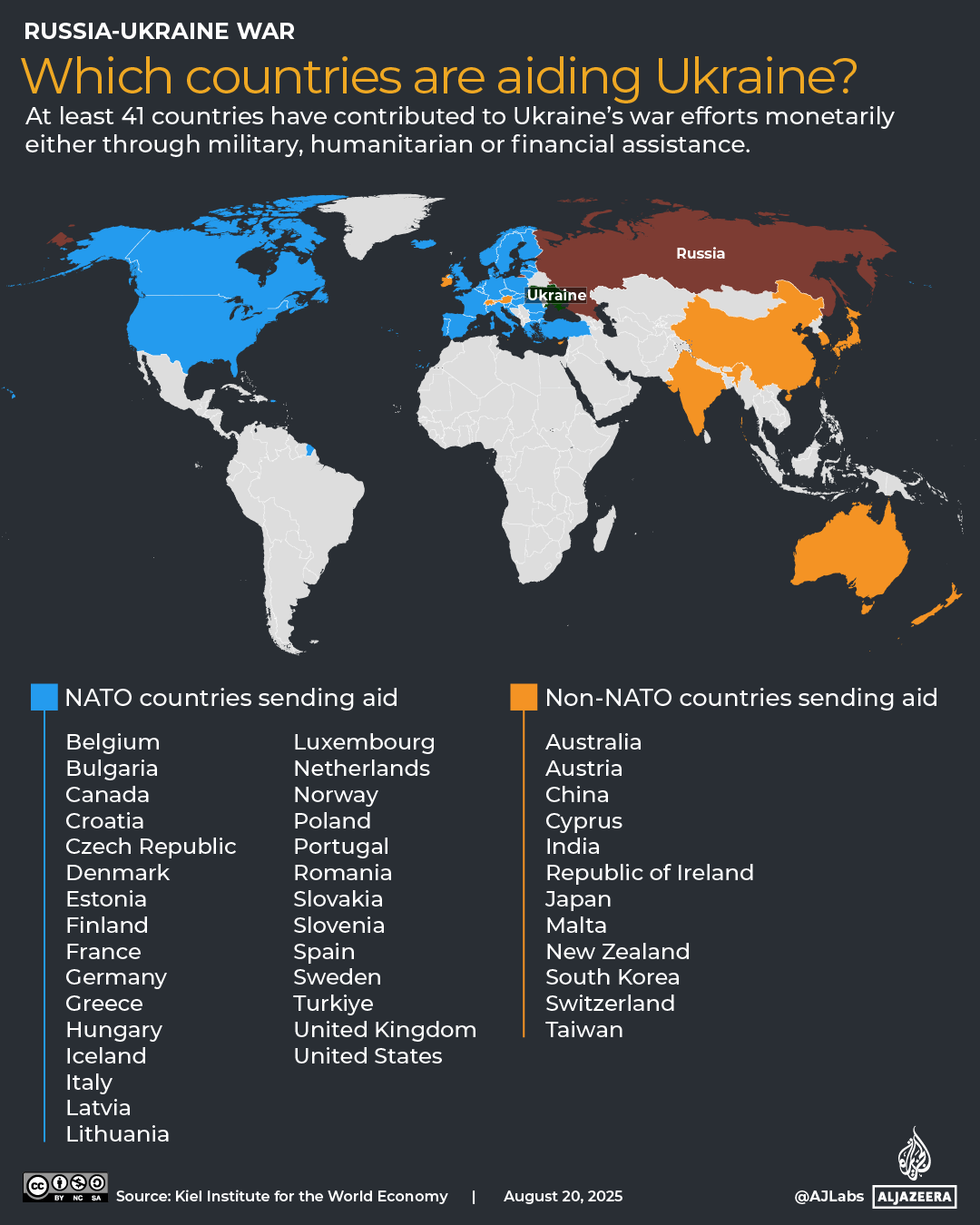Donald Trump, the president of the United States, says he is prepared to arrange a summit between Russian President Vladimir Putin and Ukrainian President Volodymyr Zelenskyy after a week of high-stakes diplomacy aimed at putting an end to the Ukrainian conflict.
Trump has reaffirmed his position on a possible deal with Ukraine and reiterated his commitment to Kyiv and said that Washington could provide air support in response to separate meetings with both leaders.
In response, Ukraine then announced to reporters at the White House that it would use $90 billion to buy American weapons from Europeans to bolster its defenses.
Which nations are providing aid to Ukraine?
According to the German think tank Kiel Institute for the World Economy, at least 41 nations have financially supported Ukraine’s war efforts financially, either financially or militarily.
The Ukrainian military receives financial, military, and other aid as well. Civilians are provided with humanitarian relief, which includes medical care, food, and other necessities, as well as financial aid in the form of grants, loans, and guarantees.
The Kiel Institute claims that 29 of NATO’s 32 members have provided financial aid to Ukraine.
Additionally, Ukraine has received financial aid from 12 non-NATO nations and territories. Australia, Austria, Cyprus, the Republic of Ireland, Japan, Malta, New Zealand, South Korea, Switzerland, China, Taiwan, and India are just a few examples.
Additionally, the European Union has provided substantial aid to Ukraine through the Commission and Council.
How much aid has Ukraine currently received?
According to the Kiel Institute, Ukraine has received more than 309 billion euros ($360 billion) in military, financial, and humanitarian aid so far:
- Military aid – 149.26 billion euros ($174bn – using today’s exchange rate of €1 = $1.17)
- Financial aid – 139.34 billion euros ($163bn)
- Humanitarian aid – 21.04 billion euros ($24bn)
Who are the biggest donors to Ukraine?
Between January 24, 2022 and June 30, 2025, the US provided 114.64 billion euros ($134bn) in aid to Ukraine.
- Military aid – 64.6 billion euros ($75bn)
- Financial aid – 46.6 billion euros ($54bn)
- 3. 4 billion euros in humanitarian aid
The second-largest donor is the EU (Commission and Council), followed by Germany (21.29 billion euros or $25 billion), the UK (18.6 billion euros or $21 billion) and Japan (13.57 billion euros or $15 billion).
How much money has been pledged and allocated?
More than the 114.6 billion euros ($134bn) that the US gave to the war in Ukraine, according to the Kiel Institute, have been allocated by the European countries as a whole to the EU.
Allocated aid refers to funds or resources that have been specifically designated, delivered, or used by Ukraine.
It differs from pledged aid, which is money or other supplies that a nation has promised but haven’t yet delivered or set aside informally.
Europe as a whole committed 257.4 billion euros ($300 billion), and the US committed 119 billion euros ($139 billion).
Under Trump, US aid to Ukraine drops dramatically.
The Biden administration provided Ukraine with one last round of military support on January 9 just days before Trump took office with a $500 million weapons package.
Aid to Ukraine has dropped dramatically since the start of the Trump administration’s second term in power, with Washington suspending all funding, including weapons, in March following a contentious White House meeting with Zelenskyy.
Trump asserted that US military aid to Ukraine totaled more than $300 billion. Despite the US being the single largest donor nation, Ukraine and its supporters have objected to that figure.
What weapons are currently available in Ukraine?
Armoured vehicles, artillery, aircraft, air defense systems, drones, missiles, and a variety of support equipment have all been provided by Ukraine from its allies.
Poland has provided 354 tanks to its neighbor, according to the Kiel Institute, while the US is in the lead with 305 infantry fighting vehicles, 201 howitzers, air defense systems, and HIMARS rocket launchers (41).
The HIMARS, which could strike targets from a distance of just a few meters (feet) from almost 80 kilometers (50 miles) away, provided Ukraine with the long-range precision strike capability that slowed Russian advance early in the conflict.
NATO defense spending
The US could assist in coordinating a security guarantee for Ukraine, the White House stated in a press release. Russia’s Ministry of Foreign Affairs, however, has blocked NATO-based troops from going to help negotiate a peace deal.
The NATO leaders signed a deal in June that will increase defense spending, which will increase by hundreds of billions of dollars annually from the current goal of 2 % of GDP (GDP), to 5 %.
23 of the 32 member nations have already accomplished this goal, and the alliance spent 2.61 percent of its GDP in defense overall last year.
Estonia and Lithuania, two NATO member states close to Russia, have significantly increased their defense spending from less than 1% of GDP ten years ago.
Source: Aljazeera

Leave a Reply